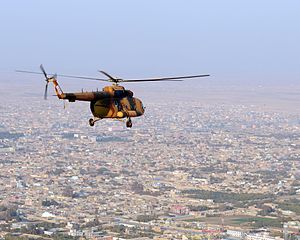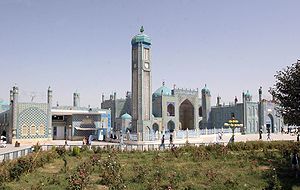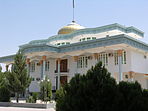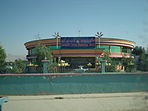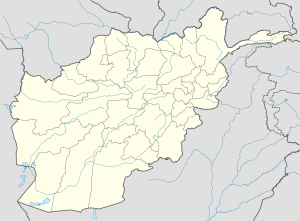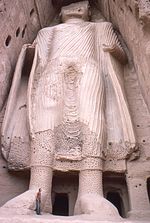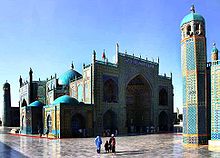- Mazar-i-Sharif
-
"Mazar" redirects here. For other uses, see Mazar (disambiguation).
Mazāri Sharīf
مزارِ شریف— City — Location in Afghanistan Coordinates: 36°42′N 67°07′E / 36.7°N 67.117°ECoordinates: 36°42′N 67°07′E / 36.7°N 67.117°E Country  Afghanistan
AfghanistanProvince Balkh Province District Mazar-e Sharif District Elevation 357 m (1,171 ft) Population (2006) - Total 375,181 Time zone Afghanistan Standard Time (UTC+4:30) History of Afghanistan Timeline Bronze age and Proto-Elamite culture in Nimruz area (2300–1800 BC) Bronze age and Indus valley civilization in Mundigak (Kandahar area) (2200–1800 BC) Bronze age and Oxus civilization in northern Afghanistan (2100–1800 BC) Late Bronze age and Iron age and coming of Aryans (1700–700 BC) Median Empire (728–550 BC) Achaemenids (550–330 BC) Seleucids (330–150 BC) Mauryans (305–180 BC) Greco-Bactrians (256–125 BC) Indo-Greeks (180–130 BC) Indo-Scythians (Sakas) (155–80? BC) Indo-Parthians (20 BC–50? AD) Kushans (135 BC–248 AD) Sassanids (230–565) Indo-Sassanids (248–410) Kidarites (320–465) Hephthalites (410–557) Kabul Shahi (565–879) Rashidun Caliphate (642–641) Umayyads (661–750) Abbasids (750–821) Tahirids (821–873) Saffarids (863–900)) Samanids (875–999) Ghaznavids (963–1187) Seljukids (1037–1194) Khwarezmids (1077–1231) Ghorids (1149–1212) Ilkhanate (1258–1353) Kartids (1245–1381) Timurids (1370–1506) Arghun (1479-1522) Mughals (1501–1738) Safavids (1510–1709) Hotaki dynasty (1709–1738) Afsharids (1738–1747) Durrani Empire (1747–1826) Emirate of Afghanistan (1826–1919) Kingdom of Afghanistan (1919–1973) Republic of Afghanistan (1973–1978) Democratic Republic (1978–1992) Islamic State (1992–1996) Islamic Emirate (1996–2001) Islamic Republic (2001–) Afghan Civil War 1979–1989 1989–1992 1992–1996 1996–2001 2001–present
Mazār-i-Sharīf or Mazār-e Sharīf (Persian/Pashto: مزارِ شریف, ˌmæˈzɒːr ˌi ʃæˈriːf) is the fourth largest city of Afghanistan, with a population of about 375,181 as of 2006. It is the capital of Balkh province and is linked by roads to Kunduz in the east, Kabul in the south-east, Herat to the west and Uzbekistan to the north. The city is a major tourist attraction because of its famous shrines as well as the Muslim and Hellenistic archeological sites. In 2006, the discovery of new Hellenistic remains was announced.[1]
The region around Mazar-e-Sharif has been historically part of Greater Khorasan and was controlled by the Tahirids followed by the Saffarids, Samanids, Ghaznavids, Ghurids, Ilkhanates, Timurids, and Khanate of Bukhara until the mid-18th century when it became part of the Durrani Empire after an agreement was signed between Amir Murad Beg and Amir Ahmad Shah Durrani. The Mazari Sharif Airport in the city has been heavily used during the 1980s Soviet war and the latest 2001-present war in Afghanistan.
Mazari Sharif means "Noble Shrine", a reference to the large, blue-tiled sanctuary and mosque in the center of the city known as the Shrine of Hazrat Ali or the Blue Mosque. Some Muslims believe that the tomb of Ali ibn Abi Talib, the cousin and son-in-law of Prophet Muhammad, is at this mosque in Mazari Sharif. Twelver Shi'as however, believe that the real grave of Ali is found within Imam Ali Mosque in Najaf, Iraq, as was disclosed by the Sixth Twelver Shi'a Imam, Ja'far as-Sadiq.[2] On the other hand, some believe that it is possible that the shrine in Mazari Sharif is of Zoroaster (Zarathushtra), the founder of the first universally monotheistic religion. As a common theme in the Iranian lands falling into the hands of the advancing Muslims, the true identity of many holy and sacred sites were hidden to prevent their sacrilege and destruction.
Contents
History
Main article: History of AfghanistanThe region around Mazar-e-Sharif has been historically part of Greater Khorasan and was controlled by the Tahirids followed by the Saffarids, Samanids, Ghaznavids, Ghurids, Ilkhanates, Timurids, and Khanate of Bukhara. According to tradition, the city of Mazari Sharif owes its existence to a dream. At the beginning of the 12th century, a local mullah had a dream in which the 7th century Ali bin Abi Talib, cousin and son-in-law of Islam's prophet Muhammad, appeared to reveal that he had been secretly buried near the city of Balkh. After conducting researches in the 12th century, the Seljuk sultan Ahmed Sanjar ordered a city and shrine to be built on the location, where it stood until its destruction by Genghis Khan and his Mongol army in the 13th century. Although later rebuilt, Mazar stood in the shadow of its neighbor Balkh, until that city was abandoned in 1866 for health reasons.[citation needed]
The city and region became part of the Afghan Durrani Empire in around 1750 when after an agreement was signed between Mir Muhammad Murad Beg and Ahmad Shah Durrani, the founding father of Afghanistan. In the late 1870s, Afghan Emir Sher Ali Khan escaped from Kabul to take refuge in Mazar-e Sharif, which was un-affected by the Anglo-Afghan wars of the 19th century between Afghanistan and then British India.
Mazar-e Sharif remained peaceful for the next one hundred years until 1979, when then neighboring Soviet Union invaded Afghanistan. During the 1980s Soviet war, Mazari Sharif was a strategic base for the Soviet Army, as they used its airport to launch air strikes on Afghan mujahideen. In the early 1990s, after the Soviet withdraw from Afghanistan, control of Mazar was contested by the Tajik militia Jamiat-e Islami, led by Ahmad Shah Massoud and Burhanuddin Rabbani, and the Uzbek militia Jumbesh-e Melli led by Abdul Rashid Dostum. As a garrison for the Soviet-backed Afghan army, the city was under the command of Dostum, who mutinied against Najibullah's government in 1992.
Under Dostum's 5 year rule from the early 1990s to early 1997, Mazar was an oasis of peace. As the rest of the nation disintegrated and was slowly taken over by the Taliban, Dostum strengthened political ties with the newly independent Uzbekistan as well as Turkey. He printed his own currency and established his own airline. This peace was shattered in May 1997, when he was betrayed by one of his generals, Abdul Malik Pahlawan, forcing him to flee from Mazar as the Taliban were getting ready to take the city.
Taliban conquest
Main article: Battles of Mazar-i-Sharif 1997-1998Between May and July 1997, the Taliban unsuccessfully attempted to take Mazar, leading to approximately 3,000 Taliban soldiers being executed or massacred by Abdul Malik and his Shia followers.[3] In retaliation for this incident, the Taliban on August 8, 1998, returned and led a six-day killing frenzy of Hazaras, a report the Taliban denied at that time.[4] Soon after, the city was occupied and taken over by the Taliban. It was this capture of Mazar, the last major city in Afghanistan to fall to the Taliban, that prompted Pakistan's recognition of the Taliban regime. Soon afterward, the United Arab Emirates, and Saudi Arabia extended official recognition to the regime, while Turkmenistan resumed relations – although the Taliban were not officially recognized by Turkmenbashi as the rulers of Afghanistan.
United States military action
Main articles: War in Afghanistan (2001-present) and Fall of Mazari SharifFollowing 9/11, Mazar Sharif was the first Afghan city to fall to the Northern Alliance (United Front). The Taliban's defeat in Mazar quickly turned into a rout from the rest of the north and west of Afghanistan. On November 9, 2001 the city was officially captured by the Afghan Northern Alliance forces after the Battle of Mazar e Sharif with help from the United States Special Operations Forces and bombing by U.S. Air Force aircraft. As many as 2,000 Taliban fighters who surrendered were reportedly massacred by the Northern Alliance after the battle, and reports also place U.S. ground troops at the scene of the massacre.[5] The Irish documentary Afghan Massacre - the Convoy of Death investigated these allegations. Filmmaker Doran claims that mass graves of thousands of victims were found by United Nations investigators.[6] The Bush administration reportedly blocked investigations into the incident.[7]
Small scale clashes between militias belonging to different commanders persisted throughout 2002, and were the focus of intensive UN peace-brokering and small arms disarmament programme. After some pressure, an office of the Afghan Independent Human Rights Commission opened an office in Mazar in April 2003. There were also reports about northern Pashtun civilians being ethnic cleansed by the other groups, mainly by ethnic Tajiks, Hazaras and Uzbeks.[8]
The city slowly came under the control of the Karzai administration after 2002, which is led by President Hamid Karzai. The 209th Corps of the Afghan National Army is based at Mazari Sharif, which provides military assistance to northern Afghanistan. The Afghan Border Police headquarters is also located in the city. Despite all the security put in place, there are reports of Taliban activities and assassinations of tribal elders. Officials in Mazar-e Sharif reported that between 20 to 30 Afghan tribal elders have been assassinated in the Balkh Province in the last several years. There is no conclusive evidence as to who is behind it but majority of the victims are said to have been associated with the Hezbi Islami political party.[9]
NATO and United Nations presence
Further information: International Security Assistance ForceThere are also NATO peacekeeping forces in and around the city providing assistance to the Afghan government. ISAF Regional Command North, led by Germany, is stationed at Camp Marmal which lies near to the city at an airport. Provincial Reconstruction Team Mazar-i-Sharif has since 2006 had unit commanders from Sweden, on loan to ISAF. The unit is stationed at Camp Northern Lights, located 10km west of Camp Marmal.
Camp Nidaros, located within Camp Marmal, has soldiers from Latvia and Norway, and is led by an ISAF-officer from Norway.
In late July 2011, NATO troops also handed control of Mazar-i-Sharif to local forces amid rising security fears just days after it was hit by a deadly bombing. Mazar-i-Sharif is the sixth of seven areas to transition to Afghan control, but critics say the timing is political and there is skepticism over Afghan abilities to combat the Taliban insurgency. Violence is at a record high in the insurgency, and transition comes as 150,000 NATO-led troops begin a gradual withdrawal designed to recall all foreign combat troops by the end of 2014.[10]
The United States Department of State is building a consulate in the city which will be operational by the end of 2011.April 2011 killings of UN workers and protesters
Main article: 2011 Mazar-i-Sharif attack Afghan National Police Training Center
Afghan National Police Training Center
On April 1, 2011, as many as 10 foreign employees working for United Nations Assistance Mission in Afghanistan (UNAMA) were killed by angry demonstrators in the city. The demonstration was organized in retaliation to pastors Terry Jones and Wayne Sapp's March 21 Qur'an-burning in Florida, United States.[11] Among the dead were five Nepalese, a Norwegian, Romanian and Swedish nationals, two of them were said to be decapitated.[12][13][14] Terry Jones, the American pastor who was going to burn Islam's Holy Book, denied his responsibility for incitement.[15] President Barack Obama strongly condemned both the Quran burning, calling it an act of "extreme intolerance and bigotry", and the "outrageous" attacks by protesters, referring to them as "an affront to human decency and dignity." "No religion tolerates the slaughter and beheading of innocent people, and there is no justification for such a dishonorable and deplorable act."[16] U.S. legislators, including Senate Majority Leader Harry Reid, also condemned both the burning and the violence in reaction to it.[17]
Climate
The climate in Mazari Sharif is very hot during the summer with daily temperatures of over 40°C or 104 degree Fahrenheit in June and July. The winters are cold with temperatures falling below freezing.
Climate data for Mazar-i-Sharif Month Jan Feb Mar Apr May Jun Jul Aug Sep Oct Nov Dec Year Average high °C (°F) 8.0
(46.4)10.7
(51.3)16.3
(61.3)24.3
(75.7)31.2
(88.2)37.0
(98.6)38.9
(102.0)36.9
(98.4)31.9
(89.4)24.7
(76.5)16.4
(61.5)10.8
(51.4)23.93
(75.07)Daily mean °C (°F) 2.6
(36.7)5.1
(41.2)10.8
(51.4)17.9
(64.2)24.5
(76.1)29.9
(85.8)33.3
(91.9)29.9
(85.8)23.9
(75.0)16.7
(62.1)9.1
(48.4)5.1
(41.2)17.40
(63.32)Average low °C (°F) −2.1
(28.2)0.0
(32.0)5.1
(41.2)11.3
(52.3)16.6
(61.9)22.5
(72.5)25.9
(78.6)23.8
(74.8)17.1
(62.8)9.4
(48.9)3.2
(37.8)0.0
(32.0)11.07
(51.92)Precipitation mm (inches) 28.9
(1.138)34.8
(1.37)43.8
(1.724)28.3
(1.114)11.2
(0.441)0.2
(0.008)0.0
(0)0.0
(0)0.1
(0.004)3.9
(0.154)13.5
(0.531)21.7
(0.854)186.4
(7.339)Source: World Climate Data[18] Demography
 Young children are photographed while ISAF troops from Norway patrol the streets in 2009.
Young children are photographed while ISAF troops from Norway patrol the streets in 2009.
The population of Mazari Sharif is around 375,181, which is a multiethnic and multilingual society. There is currently no reliable data on the exact percentage of each ethnic group but most sources suggest that the majority are Tajiks followed by Uzbeks, Hazaras, Pashtuns, Turkmen, and others.[19] Occasional ethnic fightings have been reported in the region in the last couple of decades, mainly between Pashtuns and the other groups.[8][20][21] Some latest news reports show assassinations taking place in the area but with no conclusive evidence as to who is behind it.[9]
The dominant language in Mazari Sharif is Dari (Persian) followed by Pashto, both of which are the official languages of Afghanistan.
Local events
The city is a centre for the traditional buzkashi sport, and the Blue Mosque is the focus of Afghanistan's Nawroz celebration.
Economy and transport
Mazar-e Sharif serves as the major trading center in northern Afghanistan, which is the first city to connect itself by rail with a neighboring country. The rail service from Mazar-e Sharif to Uzbekistan that began in 2011 is expected to rapidly boost the economy of the city. Cargo on freight trains arrives to the last station near Mazar-i-Sharif Airport, where the goods are reloaded onto trucks or airplanes and sent to their last destinations across Afghanistan. As the industry grows, it will provide employment for many local residents as well as large revenues for the city officials.
The local economy is dominated by trade, agriculture and karakul production; small scale oil and gas exploitation have also boosted the city's prospects.
Notable buildings
The modern city of Mazar-i Sharif is centered around the Shrine of Hazrat Ali. Much restored, it is one of Afghanistan's most glorious monuments. Outside Mazar-i Sharif lies the ancient city of Balkh.
- Airports
- Shrines and Mosques
- Universities
- Hotels
- Serena Hotel Mazar-i-Sharif[citation needed]
- Aros-e-Shahr[citation needed]
- Mazar Hotel[citation needed]
- Farhat Hotel
- Kefayat hotel[citation needed]
See also
References
- ^ "Balkh Monument". BBC Persian. http://www.bbc.co.uk/persian/afghanistan/story/2006/07/060727_s-balkh-monument.shtml. Retrieved 2011-04-01.
- ^ Shaykh Al Mufid. Kitab al Irshad, Translated by I.K.A Howard. pp.1-6
- ^ "Afghan powerbrokers: Who's who". BBC News. http://news.bbc.co.uk/2/hi/south_asia/1615824.stm#pahlawan. Retrieved 2011-04-01.
- ^ s:A brief look at the imaginary report on the situation of human rights at Mazar-I-Sharif
- ^ Harding, Luke (09-14-2002). "Afghan Massacre Haunts Pentagon". London: The Guardian. http://www.guardian.co.uk/world/2002/sep/14/afghanistan.lukeharding. Retrieved 2010-05-12.
- ^ "As possible Afghan war-crimes evidence removed, U.S. silent". McClatchy Newspapers. 12-11-2008. http://www.mcclatchydc.com/336/story/57649.html.
- ^ "US blocked probes into Afghan prisoner killings". AFP. 10-07-2009. http://www.google.com/hostednews/afp/article/ALeqM5g2bWSZ_qHnwdWmM9oXsbYHuDVbRg.
- ^ a b "Pashtuns say they're being brutalized". United States: USA Today. 05/12/2002. http://www.usatoday.com/news/world/2002/05/13/pashtuns.htm. Retrieved 2011-04-01.
- ^ a b Ehsas, Zabiullah (March 31, 2011). "Tribal elders in Balkh worry about assassinations". Afghanistan: Pajhwok Afghan News. http://www.pajhwok.com/en/2011/03/31/tribal-elders-balkh-worry-about-assassinations. Retrieved 2011-04-01.
- ^ Enayat Najafizada (July 23, 2011). "NATO hands control of Mazar-i-Sharif to Afghans". AFP. http://www.google.com/hostednews/afp/article/ALeqM5gvokSSxBerTREE-SKocgAXHMdbLQ?docId=CNG.fe768764ef7d83a788e89cdd526cf0de.9f1. Retrieved July 23, 2011.
- ^ http://www.google.com/hostednews/afp/article/ALeqM5hiqhizasRIx4id4gcrj5d09Gg_5g
- ^ [httNepal "UN staff killed during protest in northern Afghanistan"]. BBC News. April 1, 2011. httNepal. Retrieved 2011-04-01.
- ^ "10 UN workers killed, beheaded in Mazar attack". Pajhwok Afghan News. April 1, 2011. http://www.pajhwok.com/en/2011/04/01/10-un-workers-killed-beheaded-mazar-attack. Retrieved 2011-04-01.
- ^ Boone, Jon (April 1, 2011). "UN staff killed in Afghanistan amid protests over Qur'an burning". The Guardian. http://www.guardian.co.uk/world/2011/apr/01/un-staff-afghanistan-mazar-sharif-killed-quran. Retrieved 2011-04-01.
- ^ "Pastor Terry Jones: 'We are not responsible'". BBC News. April 1, 2011. http://www.bbc.co.uk/news/world-us-canada-12940596. Retrieved 2011-04-01.
- ^ Obama condemns Quran burning ‘bigotry’, Dawn, 3 April 2011
- ^ US Legislators Condemn Quran Burning, Violent Reaction, Voice of America, 3 April 2011
- ^ "World Climate Data: Mazar-I-Sharif, Afghanistan". Weatherbase. http://www.climate-charts.com/Locations/a/AH40911.php. Retrieved 2011-09-07.
- ^ Recknagel, Charles (March 14, 2002). "UN Condemns Attacks On Ethnic Pashtuns". Radio Free Europe/Radio Liberty (Prague: hewad.com). http://www.hewad.com/news2.htm. Retrieved 2011-04-01.
- ^ "Pashtuns attacked in brutal raids by rival ethnic groups". Guardian News (buzzle.com). 2008. http://www.buzzle.com/editorials/4-2-2002-15812.asp. Retrieved 2011-04-01.
- ^ "Afghanistan: Situation in, or around, Aqcha (Jawzjan province) including predominant tribal/ethnic group and who is currently in control". Immigration and Refugee Board of Canada/UNHCR. February 1, 1999. http://www.unhcr.org/refworld/country,,IRBC,,AFG,,3ae6aab050,0.html. Retrieved 2011-04-01.
- Dupree, Nancy Hatch (1977): An Historical Guide to Afghanistan. 1st Edition: 1970. 2nd Edition. Revised and Enlarged. Afghan Tourist Organization.
External links
- Map of Mazari Sharif
- Mazar-i-Sharif (German)
Fourteen largest cities in Afghanistan by population Kabul · Kandahar · Herat · Mazari Sharif · Kunduz · Jalalabad · Lashkar Gah · Taloqan · Puli Khumri · Khost · Ghazni · Sheberghan · Sari Pol · FarahCategories:- Mazar-i-Sharif
- Balkh Province
- Populated places in Balkh Province
- Populated places along the Silk Road
- Cities in Central Asia
Wikimedia Foundation. 2010.

